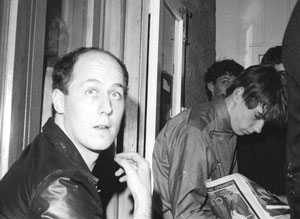Just a thought on media weirdness and the journey that erroneous data can take. In particular I’m thinking today of the reportage drivel that was the core of much of the reporting of Pauly Fuemana’s untimely death. I could write a book on the misreporting of the whole sad OMC saga, you never know where that thought might lead, and Peter Mclennan nailed it rather well here and here.
As he says: How does a one man band break up and reform?
And that’s the line in the recent bullshit that’s really got on my nerves.
Someone, and god knows who it is changed this more correct line in the OMC Wikipedia story:
By mid-1995, OMC had broken up but Fuemana used the group's acronym as a solo artist.
which in itself, I admit, is confusing in the article’s context as it refers back to the original Otara Millionaire’s Club, as appeared on the 1994 Proud album, which featured Pauly and who did indeed break up at the end of 1994 (not 1995), Pauly turning up at Alan Jansson’s door afterwards saying he wanted to carry on and Alan telling him to use the OMC tag. The agreement they made that day, and in subsequent documents that I wrote on their behalf, was that OMC was both or either of them.
That wiki confusion would have been fixed by some smart and quick editing.
But it was not to be. The editing that took place by this person on 6 December, 2009 changed the article and invented a ‘breakup’ date in 2000, without anything approaching evidence, and completely changed the factual drift of the, admittedly half baked original.
That mistake was, when the Pauly Fuemana page was created on 31 January this year (rather than re-directing to the OMC page as had been the case), carried across to the new article and then used as research data by endless nonsense stories like this, created by thoroughly lazy reporters who don’t seemingly have access to telephone or email to check data. And that linked story is now used as the citation to back the erroneous data in the Pauly Fuemana page, taking it full circle. How Bizarre indeed.
The simple truth is that OMC could not and never did ‘break up’ as they were never a group….it was a studio concept put together by Alan Jansson and Pauly. When Alan and Pauly stopped working together in 1998 (until they found themselves in the studio again after I engineered it in early 2005, but that’s another whole story), Paul carried on using the name with Alan’s agreement. He recorded demos and more under the name. Nothing ever ‘broke up’.
That shitty Stuff story also tells the viewer that the shot of Paul in a black suit and polo neck, in a red European sports car (taken whilst we were in the UK) is:
A still from OMC's music video
Which, in the real world, just happened to feature Paul in a gorgeous Polynesian styled shirt (man, he could dress) driving two others (Sina Siapaia and a Filipino guy called Pil who was a last minute stand-in because brother Pele (DJ Soane Filitonga) hadn’t showed for the shoot) in a 1968 Impala. The video ain’t that hard to find.
But, myself I’ve always preferred this vid, which features half the High Street kids of the day and I helped script. Check out his smile (and the dude with the cellphone ….bricks rule):








